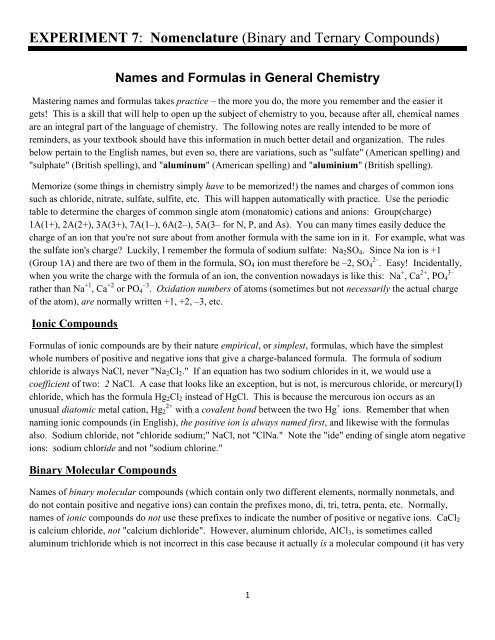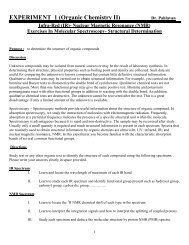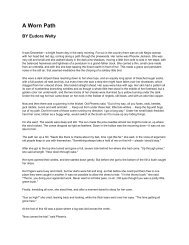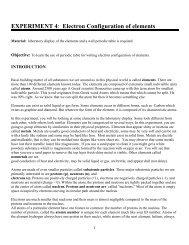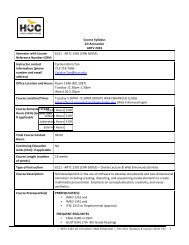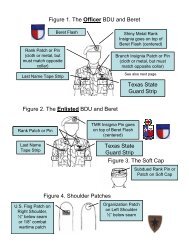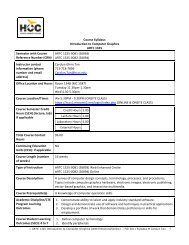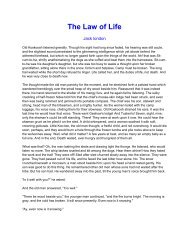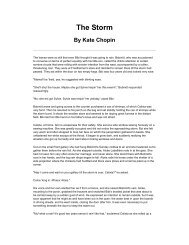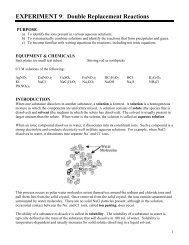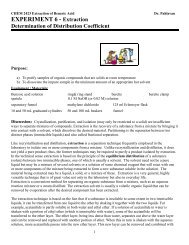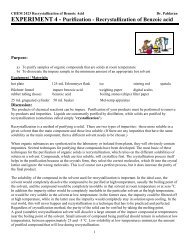EXPERIMENT 7: Nomenclature (Binary and Ternary Compounds)
EXPERIMENT 7: Nomenclature (Binary and Ternary Compounds)
EXPERIMENT 7: Nomenclature (Binary and Ternary Compounds)
Create successful ePaper yourself
Turn your PDF publications into a flip-book with our unique Google optimized e-Paper software.
<strong>EXPERIMENT</strong> 7: <strong>Nomenclature</strong> (<strong>Binary</strong> <strong>and</strong> <strong>Ternary</strong> <strong>Compounds</strong>)<br />
Names <strong>and</strong> Formulas in General Chemistry<br />
Mastering names <strong>and</strong> formulas takes practice – the more you do, the more you remember <strong>and</strong> the easier it<br />
gets! This is a skill that will help to open up the subject of chemistry to you, because after all, chemical names<br />
are an integral part of the language of chemistry. The following notes are really intended to be more of<br />
reminders, as your textbook should have this information in much better detail <strong>and</strong> organization. The rules<br />
below pertain to the English names, but even so, there are variations, such as "sulfate" (American spelling) <strong>and</strong><br />
"sulphate" (British spelling), <strong>and</strong> "aluminum" (American spelling) <strong>and</strong> "aluminium" (British spelling).<br />
Memorize (some things in chemistry simply have to be memorized!) the names <strong>and</strong> charges of common ions<br />
such as chloride, nitrate, sulfate, sulfite, etc. This will happen automatically with practice. Use the periodic<br />
table to determine the charges of common single atom (monatomic) cations <strong>and</strong> anions: Group(charge)<br />
1A(1+), 2A(2+), 3A(3+), 7A(1–), 6A(2–), 5A(3– for N, P, <strong>and</strong> As). You can many times easily deduce the<br />
charge of an ion that you're not sure about from another formula with the same ion in it. For example, what was<br />
the sulfate ion's charge Luckily, I remember the formula of sodium sulfate: Na 2 SO 4 . Since Na ion is +1<br />
(Group 1A) <strong>and</strong> there are two of them in the formula, SO 4 ion must therefore be –2, SO 4 2– . Easy! Incidentally,<br />
when you write the charge with the formula of an ion, the convention nowadays is like this: Na + , Ca 2+ , PO 4<br />
3–<br />
rather than Na +1 , Ca +2 or PO 4 –3 . Oxidation numbers of atoms (sometimes but not necessarily the actual charge<br />
of the atom), are normally written +1, +2, –3, etc.<br />
Ionic <strong>Compounds</strong><br />
Formulas of ionic compounds are by their nature empirical, or simplest, formulas, which have the simplest<br />
whole numbers of positive <strong>and</strong> negative ions that give a charge-balanced formula. The formula of sodium<br />
chloride is always NaCl, never "Na 2 Cl 2 ." If an equation has two sodium chlorides in it, we would use a<br />
coefficient of two: 2 NaCl. A case that looks like an exception, but is not, is mercurous chloride, or mercury(I)<br />
chloride, which has the formula Hg 2 Cl 2 instead of HgCl. This is because the mercurous ion occurs as an<br />
unusual diatomic metal cation, Hg 2 2+ with a covalent bond between the two Hg + ions. Remember that when<br />
naming ionic compounds (in English), the positive ion is always named first, <strong>and</strong> likewise with the formulas<br />
also. Sodium chloride, not "chloride sodium;" NaCl, not "ClNa." Note the "ide" ending of single atom negative<br />
ions: sodium chloride <strong>and</strong> not "sodium chlorine."<br />
<strong>Binary</strong> Molecular <strong>Compounds</strong><br />
Names of binary molecular compounds (which contain only two different elements, normally nonmetals, <strong>and</strong><br />
do not contain positive <strong>and</strong> negative ions) can contain the prefixes mono, di, tri, tetra, penta, etc. Normally,<br />
names of ionic compounds do not use these prefixes to indicate the number of positive or negative ions. CaCl 2<br />
is calcium chloride, not "calcium dichloride". However, aluminum chloride, AlCl 3 , is sometimes called<br />
aluminum trichloride which is not incorrect in this case because it actually is a molecular compound (it has very<br />
1
polar aluminum-chlorine covalent bonds) even though it looks like it should be ionic since it contains metal <strong>and</strong><br />
nonmetal elements typical of ionic compounds. MnO 2 is often called manganese dioxide rather than<br />
manganese(IV) oxide for the same reason. Usually, it is best to play it safe with compounds like these <strong>and</strong> use<br />
the ionic names: FeCl 3 is ferric chloride or iron(III) chloride rather than "iron trichloride." PCl 3 , a molecular<br />
compound (expected since only nonmetallic elements are present), is commonly called phosphorus trichloride,<br />
but is sometimes called "phosphorus(III) chloride." The "(III)" in the latter name, called the Stock name, would<br />
indicate the oxidation state rather than an actual charge of the phosphorus atom.<br />
Acid Names<br />
Acid names should be used when specified or usually when the acid is dissolved in water. For example,<br />
hydrogen chloride, HCl (g), which is a gaseous molecular compound, becomes hydrochloric acid, HCl (aq) a<br />
strong acid which exists as completely separated H + <strong>and</strong> Cl – ions in aqueous solution. H 2 SO 4 is normally<br />
always named by its acid name sulfuric acid, not "dihydrogen sulfate;" likewise HNO 3 is nitric acid <strong>and</strong> not<br />
"hydrogen nitrate." H 2 S (g) is hydrogen sulfide or dihydrogen sulfide, a gaseous molecular compound. In<br />
aqueous solution, H 2 S (aq), the acid name hydrosulfuric acid (a weak acid) will normally be used, especially in<br />
the context of acid behavior. Another common weak acid is acetic acid, HC 2 H 3 O 2 , which is found in vinegar.<br />
In this case, as with other common acids such as sulfuric acid, the acid name is always used; "hydrogen acetate"<br />
is not correct. (Acetic acid belongs to a class of organic compounds called carboxylic acids. These have their<br />
own special nomenclature rules as do the many other classes of organic compounds.)<br />
H<strong>and</strong>ling Variable Charges<br />
Many positive ions can have more than one charge <strong>and</strong> in such cases the charge must be specified in the name.<br />
You can indicate the positive charge with a Roman numeral in parentheses (known as the Stock number after<br />
the German chemist Alfred Stock), or by using the common name endings ous (for the lower common charge)<br />
<strong>and</strong> ic (for the higher common charge). Since iron can form +2 or +3 ions commonly, the names of ionic iron<br />
compounds must be unambiguous in this regard. FeCl 2 is iron(II) chloride or ferrous chloride, not "iron<br />
chloride." On the other h<strong>and</strong>, since the calcium ion, for example, always has the same charge (+2), we call<br />
CaCl 2 simply calcium chloride <strong>and</strong> not "calcium(II) chloride" because we know automatically that the charge of<br />
calcium ion is +2.<br />
Oxyanions<br />
Remember, with the oxyanion (or "oxoanion") names that the "ite" ion simply has one less oxygen than the<br />
"ate" ion, but the charge is still the same. Na 2 SO 4 = sodium sulfate, Na 2 SO 3 = sodium sulfite. These translate<br />
into the acid names sulfuric acid, H 2 SO 4 , <strong>and</strong> sulfurous acid, H 2 SO 3 . Also, if the oxyanion has one more<br />
oxygen than the "ate" ion, add the prefix per to the ate ion name, <strong>and</strong> if there is one less oxygen than the "ite"<br />
ion, add the prefix hypo to the ite name.<br />
2
You probably have the chlorate series in your textbook as an example:<br />
ClO –<br />
4<br />
ClO –<br />
3<br />
ClO –<br />
2<br />
ClO –<br />
= perchlorate ion (one more oxygen than chlorate)<br />
= chlorate ion<br />
= chlorite ion<br />
= hypochlorite ion (one less oxygen than chlorite)<br />
And the corresponding acid names:<br />
HClO 4 = perchloric acid<br />
HClO 2 = chlorous acid<br />
HClO 3 = chloric acid<br />
HClO = hypochlorous acid<br />
IUPAC Names<br />
Systematic names from the IUPAC rules (International Union of Pure <strong>and</strong> Applied Chemistry) are sometimes<br />
used to name complex inorganic compounds (the IUPAC rules are the st<strong>and</strong>ard for organic compounds). Here<br />
are some examples:<br />
NaClO 4 = sodium tetraoxochlorate(VII)<br />
Na 2 SO 4 = sodium tetraoxosulfate(VI)<br />
Na 2 SO 3 = sodium trioxosulfate(IV)<br />
NaAlCl 4 = sodium tetrachloroaluminate(III)<br />
While the last name is in common use, the other three compounds (<strong>and</strong> most other inorganic compounds) are<br />
almost always named according to the common rules outlined above - sodium perchlorate, sodium sulfate, <strong>and</strong><br />
sodium sulfite.<br />
Naming Hydrated salts<br />
Hydrates are crystalline solids that contain a fixed number of water molecules as an integral part of their<br />
crystalline structure. The number of water molecules bound per metal ion is often characteristic of that particular<br />
metal ion. One of the more common hydrates is copper(II) sulfate pentahydrate, which contains 5 moles of water<br />
per 1 mole of copper(II) sulfate, written as CuSO 4·5H 2 O. It is used as a catalytic precursor, fungicide, <strong>and</strong> as a<br />
source of copper in chemical manufacturing processes. Epsom salt is magnesium sulfate heptahydrate,<br />
MgSO 4·7H 2 O. Epsom salt is used to reduce inflammation when applied externally.<br />
3
<strong>EXPERIMENT</strong> 7: <strong>Nomenclature</strong> (<strong>Binary</strong> <strong>and</strong> <strong>Ternary</strong> <strong>Compounds</strong>)<br />
REPORT FORM<br />
Instructor ________________________<br />
Worksheet I - <strong>Binary</strong> <strong>Compounds</strong><br />
1. Al 2 O 3 ____________________<br />
2. SiI 4 ______________________<br />
3. AsF 3 _____________________<br />
4. Cs 3 N _____________________<br />
5. SiO 2 _____________________<br />
6. N 2 O 5 _____________________<br />
7. LiCl _____________________<br />
8. B 2 S 3 _____________________<br />
9. K 2 O _____________________<br />
10. PF 5 ______________________<br />
11. BeO _____________________<br />
12. SeCl 2 ____________________<br />
13. I 2 O 7 _____________________<br />
14. BaI 2 _____________________<br />
15. MgS _____________________<br />
16. Na 3 N ____________________<br />
17. OF 2 ______________________<br />
Name ___________________________<br />
Date ____________________________<br />
barium sulfide __________________<br />
phosphorus triiodide _____________<br />
sulfur trioxide __________________<br />
aluminum selenide _______________<br />
silicon disulfide _________________<br />
carbon dioxide _________________<br />
sodium oxide ___________________<br />
carbon monoxide ________________<br />
lithium fluoride _________________<br />
boron trichloride ________________<br />
lithium phosphide _______________<br />
diarsenic pentoxide ______________<br />
aluminum oxide _________________<br />
strontium fluoride _______________<br />
potassium sulfide ________________<br />
sodium sulfide __________________<br />
cesium telluride _________________<br />
4
Worksheet II: Stock <strong>Nomenclature</strong><br />
1. Cu 3 P 2 _______________________ 9. Sn 3 (PO 4 ) 2 ____________________<br />
2. Pb 3 (PO 4 ) 2 ____________________ 10. Cu(ClO 3 ) 2 ____________________<br />
3. Fe 2 (SO 4 ) 3 ____________________ 11. FePO 4 _______________________<br />
4. PbO 2 ________________________ 12.HgBr 2 _______________________<br />
5. PbSO 4 _______________________ 13.Fe 2 (SO 4 ) 3 ____________________<br />
6. CuI _________________________ 14.Sn(SO 4 ) 2 ____________________<br />
7. PbO ________________________ 15.Cu(OH) 2 ____________________<br />
8. Fe(CN) 2 _____________________<br />
iron(II)sulfide ______________<br />
copper(II)oxide _____________<br />
tin(IV)carbonate _____________<br />
copper(II)nitrate _____________<br />
lead(IV)iodide ______________<br />
copper(I)acetate______________<br />
tin(II)phosphide _____________<br />
lead(II)fluoride______________<br />
tin(II)oxalate _______________<br />
iron(II)hydroxide_____________<br />
copper(I)sulfite ______________<br />
lead(II)nitrite _______________<br />
iron(II)sulfide _______________<br />
lead(II)phosphate____________<br />
iron(III)permanganate_________<br />
copper(II)nitrate ______________<br />
tin(IV)chloride _______________<br />
5
Worksheet III: Polyatomic Salts <strong>Nomenclature</strong><br />
1. Mg(ClO 3 ) 2 ________________<br />
2. Na 2 SO 4 ___________________<br />
3. Mg(CN) 2 _________________<br />
4. Na 3 PO 4 ___________________<br />
5. NaClO ___________________<br />
6. Rb 2 CO 3 __________________<br />
7. Cs 2 C 2 O 4 __________________<br />
8. BeCO 3 ___________________<br />
9. NaCH 3 CO 2 ________________<br />
10. BaSO 3 ___________________<br />
11. Mg(NO 2 ) 2 ________________<br />
12. CaCO 3 ___________________<br />
13. Al(OH) 3 __________________<br />
14. (NH 4 ) 2 SO 4 ________________<br />
15. Sr(ClO 3 ) 2 _________________<br />
16. Na 2 O ____________________<br />
sodium cyanide ________________<br />
lithium chlorate ________________<br />
rubidium sulfate _______________<br />
beryllium cyanide ______________<br />
calcium phosphate _____________<br />
cesiumcar bonate ______________<br />
potassium dichromate __________<br />
ammonium acetate _____________<br />
strontium chromate ____________<br />
sodium permanganate __________<br />
magnesium phosphate __________<br />
potassium nitrite _______________<br />
barium hydroxide ______________<br />
zinc hypochlorite _______________<br />
6
Worksheet IV Extra <strong>Nomenclature</strong> Exercises<br />
Hydrates Salts<br />
1. SnCl 2 H 2 O ______________________________<br />
2. BaI 2 H 2 O _______________________________<br />
3. NaCH 3 CO 2 3H 2 O _________________________<br />
4. CuSO 4 5H 2 O ____________________________<br />
5. Ca(ClO 2 ) 2 3H 2 O __________________________<br />
6. Na 3 PO 4 10H 2 O ___________________________<br />
zinc acetate dihydrate ____________________________<br />
ammonium phosphate trihydrate ___________________<br />
sodium hypochlorite pentahydrate __________________<br />
barium nitrite monohydrate _______________________<br />
calcium bromide hexahydrate ______________________<br />
iron(III)bromide hexahydrate ______________________<br />
lead(II)perchlorate trihydrate ______________________<br />
magnesium iodide octahydrate _____________________<br />
7
Worksheet V: <strong>Nomenclature</strong> Review<br />
1. K 2 S _____________________ 9. Al 2 O 3 ____________________<br />
2. Mg(NO 3 ) 2 3H 2 O ____________________<br />
3. P 4 O 10 ____________________ 10. FeSO 3 ____________________<br />
4. K 2 C 2 O 4 ___________________ 11. KMnO 4 __________________<br />
5. Ba 3 (PO 4 ) 2 _________________ 12. SF 6 ______________________<br />
6. LiHCO 3 __________________ 13.NH 4 CH 3 CO 2 ______________<br />
7. AgCl ____________________ 14.Fe(HSO 4 ) 2 ________________<br />
8. CuF 2 2H 2 O ________________________ 15. NaOH ___________________<br />
lead(IV)perchlorate ______________<br />
sodium hypochlorite _____________<br />
silicon tetraiodide _______________<br />
lead(IV)perchlorate ______________<br />
sodium oxalate __________________<br />
barium chloride _________________<br />
barium nitrite tetrahydrate _________________<br />
calcium chromate ________________<br />
copper(II)acetate monhydrate ______________<br />
potassium iodide ________________<br />
aluminum chlorate _______________<br />
aluminum dichromate ____________<br />
lead(IV)bicarbonate ______________<br />
phosphorus pentafluoride _______________<br />
ammonium sulfide _______________<br />
magnesium hydroxide ____________<br />
zinc sulfide _____________________<br />
8
strontium telluride _______________<br />
sodium hypochlorite _____________<br />
silicon tetraiodide _______________<br />
sodium sulfate __________________<br />
sodium oxalate __________________<br />
barium chloride _________________<br />
barium nitrite tetrahydrate ___________________<br />
copper(II)acetate monohydrate _______________<br />
calcium chromate ________________<br />
potassium iodide ________________<br />
aluminum chlorate _______________<br />
aluminum dichromate ____________<br />
lead(IV)bicarbonate ______________<br />
strontium telluride _______________<br />
phosphorus pentafluoride _________<br />
ammonium sulfide _______________<br />
magnesium hydroxide ____________<br />
zinc sulfide _____________________<br />
sodium sulfate __________________<br />
9
<strong>EXPERIMENT</strong> 7: <strong>Nomenclature</strong> (<strong>Binary</strong> <strong>and</strong> <strong>Ternary</strong> <strong>Compounds</strong>)<br />
Pre-Laboratory Questions <strong>and</strong> Exercises<br />
Due before lab begins. Answer in the space provided.<br />
1. Define Hydroacids <strong>and</strong> Oxyacids. Give two examples of each.<br />
Name:____________________________<br />
2. Identify the following as acidic or basic oxides.<br />
CaO CO 2 K 2 O SO 3 MgO<br />
3. Write the formula for the following acids.<br />
Hydrosulfuric acid nitric acid hydroiodic acid perbromic acid<br />
4. Complete <strong>and</strong> balance the following reactions.<br />
a) K + O 2 c) Zn + HCl <br />
b) CaO + H 2 O d) Cl 2 + KI <br />
5. Write the charges for the following.<br />
SO 4 HCO 3 NO 3 C 2 H 3 O 2 PO 3 OH<br />
10
<strong>EXPERIMENT</strong> 7: <strong>Nomenclature</strong> (<strong>Binary</strong> <strong>and</strong> <strong>Ternary</strong> <strong>Compounds</strong>)<br />
Post-Laboratory Questions <strong>and</strong> Exercises<br />
Due after completing the lab. Answer in the space provided.<br />
1. Which of the following reactions is not balanced (write Yes or No)<br />
a) Zn + H 2 SO 4 ZnSO 4 + H 2<br />
Name:____________________________<br />
b) 4NH 3 + 5O 2 4 NO + 6H 2 O<br />
c) (NH 4 ) 2 CO 3 NH 3 + CO 2 + 4H 2 O<br />
2. What are the correct names for the following ions<br />
NH 4 + NO 2 - H 2 PO 3 2- Cr 2 O 7 2- HSO 4 -<br />
3. Which of the following reactions will not occur (Write Yes or No)<br />
a) Br 2 + KI c) Cu + HCl <br />
b) Mg + Zn(NO 3 ) 2 d) I 2 + NaBr <br />
4. Write the correct formula for the following compounds.<br />
Dinitrogen trioxide Oxygen difluoride Carbon disulfide Phosphorous pentoxide<br />
11


